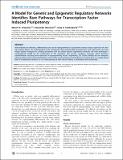A model for genetic and epigenetic regulatory networks identifies rare for transcription factor induced pluripotency
Author(s)
Artyomov, Maxim N.; Meissner, Alexander; Chakraborty, Arup K.
DownloadArtyomov-2010-A model for genetic.pdf (1.043Mb)
PUBLISHER_CC
Publisher with Creative Commons License
Creative Commons Attribution
Terms of use
Metadata
Show full item recordAbstract
With relatively low efficiency, differentiated cells can be reprogrammed to a pluripotent state by ectopic expression of a few transcription factors. An understanding of the mechanisms that underlie data emerging from such experiments can help design optimal strategies for creating pluripotent cells for patient-specific regenerative medicine. We have developed a computational model for the architecture of the epigenetic and genetic regulatory networks which describes transformations resulting from expression of reprogramming factors. Importantly, our studies identify the rare temporal pathways that result in induced pluripotent cells. Further experimental tests of predictions emerging from our model should lead to fundamental advances in our understanding of how cellular identity is maintained and transformed.
Date issued
2010-05Department
Massachusetts Institute of Technology. Department of Biological Engineering; Massachusetts Institute of Technology. Department of Chemical Engineering; Massachusetts Institute of Technology. Department of ChemistryJournal
PLoS Computational Biology
Publisher
Public Library of Science
Citation
Artyomov, Maxim N., Alexander Meissner, and Arup K. Chakraborty. “A Model for Genetic and Epigenetic Regulatory Networks Identifies Rare Pathways for Transcription Factor Induced Pluripotency.” PLoS Comput Biol 6.5 (2010): e1000785.
Version: Final published version
ISSN
1553-7358
1553-734X